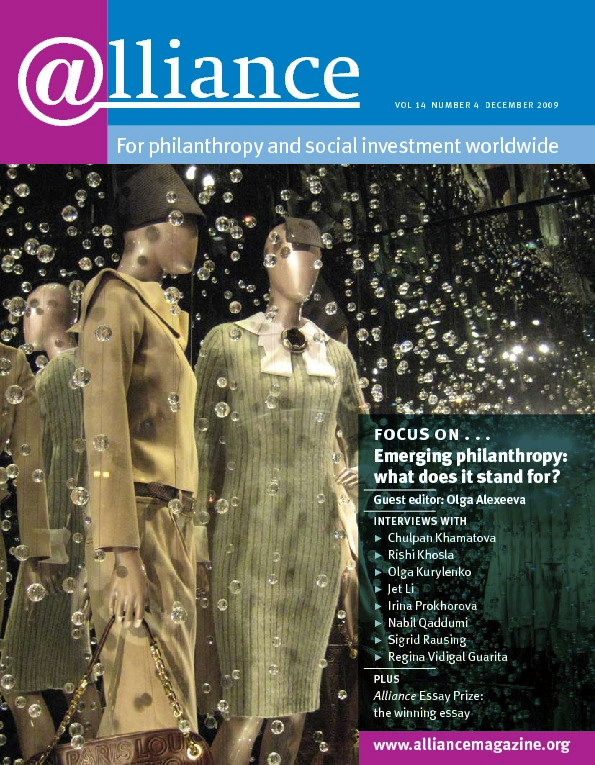High net worth individuals are responsible for 50 per cent of annual charitable giving in the US, but they do not have access to appropriate philanthropy advice. While foundations, which provide only 13 per cent of annual giving, are catered to by specialized consultants and small donors are aptly served by low-cost administrators, services for those who give the most are lacking. The ‘missing middle’ is the role of private client adviser, who can provide personalized advice in a relationship-based format rather than on a more traditional consultant model. The creation and propagation of this role offers a huge opportunity to dramatically increase the impact of the largest segment of US giving.
There are essentially four segments of philanthropy advice:
- Institutional consultants. These serve the needs of large staffed foundations, analogous to consultants who serve large corporations. Their role is to provide niche expertise or an outside perspective.
- Family office services. Advisers provide a staffing solution for ultra-wealthy families with a net worth in the hundreds of millions or billion dollar range, performing much the same function as multi-family offices in the wealth management world.
- Retail services. Community foundations and commercial donor advised funds offer self-directed donors effective administrative services. The average account size at US commercial donor advised funds is $150,000 while at community foundations it is $450,000.
Private client services
So far, these are much like the services offered in the wealth management world. An ultra high net worth individual can access family office services. People with less than $1 million in assets often work with retail financial service providers. But the wealth management world offers another tier of service that until recently has been absent from the philanthropic world: private client services.
The world of wealth management offers wealth advisory services to people with more than $1 million but not enough for (or no interest in) a family office solution. These ‘private client advisers’ work with between 60 and 90 high net worth families and provide advisory services. The best become trusted advisers to their clients and help them navigate a lifetime of wealth management issues.
Such a role is sorely needed in the philanthropy adviser market. Philanthropists with between $1 million and $30 million in philanthropic assets do not need staff to handle their giving, nor do they have any interest in ‘outsourcing’ an activity about which they are passionate. Even donors with much higher levels of philanthropic assets may not want to staff up a significant organization or outsource their philanthropy to a family office provider. What they need is customized, cost-effective philanthropy advice, which provides significantly higher levels of service than retail service providers but is cheaper than hiring permanent staff or a research consultant service.
Individual donors not unwilling to pay …
This sort of service is fundamentally different from the far more prevalent programmatic consulting service that is appropriate for staffed foundations. A high net worth individual who gives, for instance, $200,000 a year to charity is unlikely to be interested in spending $10,000 to commission a report on the effectiveness of various non-profit programmes. While a staffed foundation views consultant fees as a cost of doing business, the high net worth donor sees a project-based fee as reducing the amount of money they have available to give. More generally, high net worth donors needs advice on all aspects of their giving and paying large fees for programmatic research is beyond the means (and likely interest) of even very wealthy donors.
The fact that individual donors are wary of paying for consulting services that are more appropriate for staffed foundations has led to the incorrect assumption that donors are unwilling to pay for advice: consider the fact that US community foundations currently hold about $10 billion in donor advised funds on which they charge a fee and provide advice to their donors. But an average account size of just $450,000 means that community foundations are unable to provide the customized, in-depth advice that high net worth individuals are accustomed to receive from their other professional advisers.
… but transaction costs need to fall
For a private client adviser function to be feasible, administrative costs must be minimal. The private client adviser role in US wealth management did not become widespread until the 1980s and early 1990s. The precipitating event was the fact that in 1975, Charles Schwab & Co began offering discount brokerage services for the first time. Once transaction costs had fallen, private client advisers could charge an advisory fee that stayed cost-effective for the client even after adding in the transaction costs.
A similar event happened in philanthropy in 2006 when both Schwab and Fidelity’s charitable gift funds cut their fee schedule in half. Today the transaction costs for donor advised funds and private foundations have plummeted to the degree that private client advisory fees can be added on top without making the cost of the total package prohibitive.
Maximizing impact
The last 30 years have seen the professionalization of foundation grantmaking. Today’s programme officers have access to vast amounts of accumulated knowledge, consulting services, best practices and technology-driven tools. Private donors, on the other hand, have access to efficient transaction services and the occasional exceptional retail service provider who goes above and beyond to serve their clients’ needs.
For the sake of maximizing impact, we desperately need to develop private client services for major donors. The low-cost transaction platforms are in place. Supporting services like the Chartered Advisor in Philanthropy credentialling programme[1] or the nascent Association of Nonprofit Analysts are becoming more prevalent. My own firm, Tactical Philanthropy Advisors, is focused exclusively on this private client market. But with 600,000 families in the US alone giving between $50,000 and $1 million a year, a field needs to be built to serve them. It is high time that our sector stopped focusing on the concentrated pools of capital at staffed foundations and realized that far more impact will be achieved when we figure out how to serve the needs of private donors who collectively make the vast majority of philanthropic donations.
1 The CAP programme is the leading credential for philanthropy advisers in the US, including commercial DAFs.
Sean Stannard-Stockton is CEO of Tactical Philanthropy Advisors and author of the Tactical Philanthropy blog. Email sean@tacticalphilanthropy.com
 Comment Laura Starita
Comment Laura Starita
For donors, the desire to make a difference can create unrealistic expectations. I blame the internet. In a world where one needs three minutes and a broadband connection to identify the standard treatment for guinea worm, donor attention span has been reduced to the point that we confuse data with knowledge. Too often we want quick understanding and quick wins. Yet dig below the surface and it is difficult to gain an accurate sense of how far a dollar goes, and what a realistic result might be. Charitable organizations, for their part, have not effectively engaged the donor community in discussion of social issues and the approaches they employ to relieve them.
Sean Stannard-Stockton argues that in this environment, individual donors would be well served by a robust industry of philanthropic advisers. I agree, but I believe something more fundamental is also needed.
Historically, donors have tended to trust the non-profits they fund while receiving very little information from them. Fraud scandals of the past decade have helped erode that trust, but the real erosion derives from a more banal source: namely, that social problems still exist. Donors see the amount of money given and the failure to solve the problems and conclude that the organizations they put their trust and funds into were not worthy. Sometimes that is the right conclusion, but not always. Yet it is hard to know the difference, since most non-profits simply count numbers of beneficiaries and avoid the fuzzy problem of evaluating whether the beneficiary is better off. As a result we know very little about which approaches work best for which problems.
This needs to change, and donors need to help change it by being willing to pay for good information. They can do that by providing financial support to those organizations willing to conduct studies on their own programmes and make transparent programme design and study results for others to use. Such information can help everyone identify what works and what does not, and can begin to build the information infrastructure so needed in philanthropy, and so necessary to the ability of donors and advisers alike to effect positive change.
Laura Starita is the managing editor of Philanthropy Action, an online journal for high net worth donors. Email laura.starita@philanthropyaction.com






Comments (0)